By Dave DeWitt
Recipes:
Pineapple-Mango Salsa Soup
Marie’s Green Mango Chutney
Green Mango Slaw with Papaya Seed Dressing
Beef Kabobs Tropicale
Spiced-Up Chicken in Coconut Shells
with Mango Cream
Grilled Scallops with a Rocotillo Mango Relish
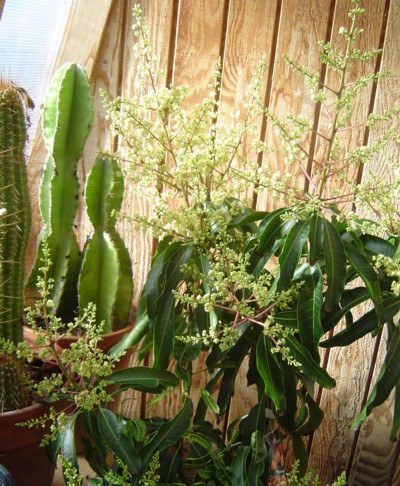
Mangos Blooming in My Greenhouse
Mangos originated in east India, Burma and the Andaman Islands bordering the Bay of Bengal and have been cultivated since at least 2000 B.C. Around the 5th century B.C., the mango was introduced, perhaps by Buddhist monks, to Malaysia. (Legend holds that Buddha found tranquility in a mango grove.)
Persian traders took the mango into the Middle East and Africa, and from there the Portuguese brought it to Brazil and the West Indies. In India in the 16th century, the Moghul ruler Akbar planted a huge orchard, called Lakh Bagh because the supposed number of trees was one lakh (100,000). Mango cultivars arrived in Florida in the 1830s and in California in the 1880s. Today, more than 150 varieties of mango are grown in Florida.
Mangos, like apples, do not grow true from seeds, so they are propagated by taking cuttings and rooting them. The fruits vary in size and weight from 2 inches and 4 ounces to 10 inches and over 4.5 pounds. The finest mangos have a pleasant, faintly resinous aroma and the worst ones smell like kerosene.
Legend holds that fresh, ripe mangos are so juicy that they are best eaten while nude in a bathtub. The fruit is less dramatically preserved by drying, canning in syrup, or pickling. Green mangos are made into fiery hot chutneys and are often pickled as well. East Indians, great lovers of mangos that they are, take things a step further and turn the mangos into cereal flakes, custard powder, and toffee. In Vietnam, salted mango slices are eaten with green chile, while in Mexico the slices are served covered with red chile powder. Mango shakes, called batidos are popular in Florida and the Caribbean.
In 2005 while visiting my brother in Florida, I drove across the peninsula from Sarasota to Coral Gables to visit the Fairchild Tropical Botanic Garden, and was astonished to see the size of their mango trees. After seeing ads for mango trees in their magazine, The Tropical Garden, I bought two small ones, a ‘Julie’ and ‘Neelum’. I had tasted the ‘Julie’ variety in Trinidad and loved the flavor. These are dwarf varieties that can live in large pots. “Condo mangos,” they are called by Dr. Richard Campbell, the curator at Fairchild. They tolerated our dry New Mexico summers well on the front porch and spent the winter in the greenhouse. But alas, they flowered at different times and I didn’t get any fruit–cross-pollination is required for fruit set. But things are looking up.
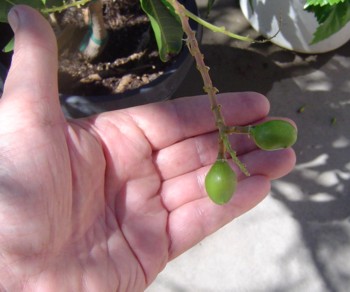
Baby Mangos
As I write this in the spring of 2007, both varieties flowered at approximately the same time, and the result was 13 little mango fruits on the two mini-trees. I’m hoping that they don’t drop off and we’ve have succulent mango slices in the late summer to pair with the chile peppers I always grow. What I forgot was that the cross-pollination of two different varieties will result in F-1 hybrids, like crossing a serrano with a bell pepper, or a collie with a dachshund. But I’ll still eat my home-grown mangos in the bathtub, naked, with Jimmy Buffett playing on Internet radio from my bathroom WiFi connection.
They continue to grow…
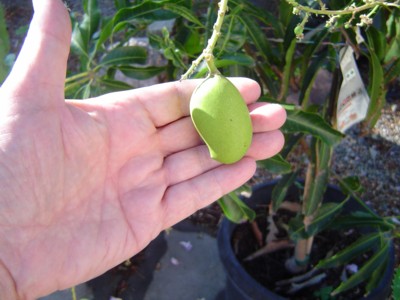
July, 2007 Update: I’ve lost a few mangos to wind, but the remaining four of them continue to grow!
September, 2007 Update: Success, with four tasty, medium-sized mangos.
Mango Factoids
- In his Kama Sutra, Vatsyayana advises lovers to drink mango juice before making love.
- There are more than 40 species and 400 varieties of mangos throughout the world.
- The mango is a member of the cashew family of flowering plants; other species include the pistachio tree and poison ivy.
- Top mango exporters are India, Pakistan, Puerto Rico, Mexico, Brazil, Israel, South Africa and Peru.
- Mangos are rich in vitamin A and have good amounts of vitamins B and C as well as potassium, calcium and iron.
- Dermatitis can result from contact with the resinous latex sap that drips from the stem end when mangos are harvested. The mango fruit skin is not considered to be edible.
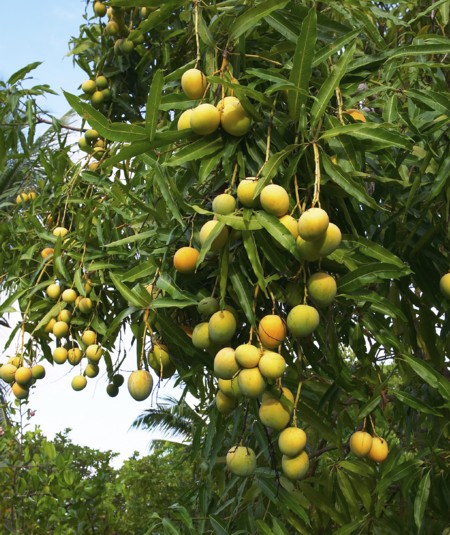
Mangos Ripening on the Tree
More Information on Mangos
Books:
The Great Mango Book, by Allen Susser. Ten Speed Press, 2001.
The Mongo Mango Cookbook, by Cynthia Thuma. Pineapple Press, 2001.
Festival:
The International Mango Festival is held in mid-July at Fairchild Tropical Botanic Garden in Coral Gables, Florida. Information at fairchildgarden.org.
Websites:
http://www.freshmangos.com
www.mango.co.za
www.tropicalfruitnursery.com
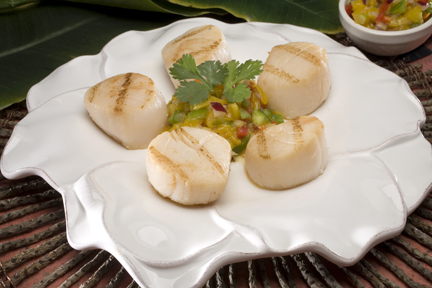
Photo by Norman Johnson; Styling by Denice Skrepcinski
Chris Schlesinger, of the East Coast Grill in Cambridge, Massachusetts, sent us this recipe, which was published in an early issue of Chile Pepper magazine. The sharp spiciness of the chile combines easily with mellow sweetness of the mango to create a strong by not overpowering accompaniment for the creamy taste of the scallops.
1 cup rocotillo chiles, seeds and stems removed, minced, or substitute 1 habanero plus 5 yellow wax chiles
1 small purple onion, diced
1 green bell pepper, stemmed, seeded and diced
1 red bell pepper, stemmed, seeded and diced
2 ripe mangos, peeled and diced
Juice of 3 oranges
1/2 cup pineapple juice
Juice of 4 limes
1/4 cup chopped cilantro
2 pounds sea scallops
Water
Salt and freshly ground black pepper to taste
To make the relish, in a bowl combine all the ingredients, except the scallops, water, salt, and pepper and mix well.
Blanch the scallops in boiling water in a saucepan for 2 1/2 minutes. Drain, pat dry, and sprinkle with the salt and pepper.
Thread the scallops on skewers and grill over a medium hot fire until they are golden brown on the outside and opaque throughout, about 2 to 3 minutes per side.
Make a bed of the relish on each plate and place the scallops on top and serve.
Yield: 4 servings
Heat Scale: Medium
Spiced-Up Chicken in Coconut Shells with Mango Cream

Photo by Norman Johnson; Styling by Denice Skrepcinski
2 cloves garlic, minced
1 tablespoon butter
1 tablespoon olive oil
1 pound skinless chicken, cut in 1-inch cubes
1 onion, minced
1 Scotch bonnet or habanero, stemmed, seeded and minced
1 tablespoon minced fresh ginger
1 tablespoon chopped cilantro
2 teaspoons ground cardamom
2 teaspoons ground cinnamon
2 teaspoons curry paste (available in Asian markets)
1/4 teaspoon ground cumin
1/4 teaspoon ground cloves
1 tablespoon cornstarch
1/2 cup light cream
1 large ripe mango, peeled and diced
Garnishes: Chopped fresh cilantro, reserved toasted grated coconutCut the coconuts in half and cut out the coconut meat, leaving 1/4-inch of the meat attached to the nuts. Cut 2 cups of the meat into thin slivers and grate 1 cup of the remaining meat.Preheat the broiler and sprinkle the grated coconut onto a pan and place it under the broiler. Toast for 5 to 10 minutes, shaking the pan frequently, until the coconut is golden brown.
Saute the garlic for 1 minute in the butter and oil in a large skillet. Add the chicken and saute until browned. Remove and keep warm. Add the onion, Scotch bonnet, ginger, and reserved coconut slivers. Saute for an additional 5 minutes.
Stir in the reserved coconut water and cilantro and return the chicken. Add the cardamom, cinnamon, curry paste, cumin, and cloves, cover and simmer for 30 minutes.
Mix the cornstarch with the cream in a small bowl. Add to the chicken mixture along with the mango and cook for 5 minutes or until thickened.
Spoon the mixture into the coconut shells, garnish with the chopped cilantro and toasted coconut and serve.
Yield: 4 servings
Heat Scale: Medium
Here’s a cold soup with a wonderfully fruity taste. It nicely combines mangos and Scotch bonnet chiles, but you can substitute any fresh chile that you have on hand.
2 cups fresh pineapple chunks
1 cucumber, peeled, seeded and chopped
2 green onions, chopped
1 teaspoon finely chopped Scotch bonnet
1 cup chopped mango
1 yellow bell pepper, stemmed, seeded and finely chopped
1 cup unsweetened pineapple juice
1/4 cup fresh lime juice
2 tablespoons chopped cilantro leaves
1 teaspoon sugar
Salt to taste
Place the pineapple, cucumbers, green onion, Scotch bonnet, mango, and bell pepper in a blender or food processor and puree until smooth. Transfer to a bowl and add the remaining ingredients and salt to taste and stir well.
Cover and refrigerate for an hour before serving.
Yield: 4 to 6 servings
Heat Scale: Medium
Marie’s Green Mango Chutney
One evening at Marie Permenter’s house in Trinidad, with Scotch-and-coconut water cocktails in hand, Mary Jane and I began discussing the versatility of mangos. Marie dashed into the kitchen and proceeded to whip up the following chutney for us to taste. Because of the ingredients, one would think that the taste is overwhelming. But quite the contrary; it is delicate and can be used as a dip for chips (plantain chips work well), vegetables, or crackers. Spanish thyme is also known as Indian borage (Coleus amboinicus), and Cuban oregano. Its origin is unknown, but it is grown as a fresh herb in many parts of the Caribbean.
1 head garlic, peeled, pureed in a blender
4 green mangos, peeled, pits removed, and coarsely diced
1 tablespoon sugar
1/2 Congo pepper or habanero, seeds and stems removed, minced
1 pinch salt
4 leaves Shadow Bennie (culantro) or substitute 1/4 cup fresh cilantro
1 leaf Spanish thyme or substitute 1 teaspoon fresh thyme and 1/2 teaspoon fresh Greek oregano
Combine all ingredients with the garlic in the blender and blend until the mixture is very fine and almost runny. Serve immediately or cover and refrigerate for later use. Bring to room temperature before serving.
Yield: 6 to 8 servings
Heat Scale: Medium
Green Mango Slaw with Papaya Seed Dressing
Here is a tropical change from the usual celery seed coleslaw. Allow the dressing to sit as long as possible to build up the heat.
2 green mangos, peeled and pitted
1/2 papaya, peeled, reserving 3 tablespoons of the seeds
1 cup shredded cabbage
1 small purple onion, thinly sliced
Chopped fresh watercress for garnish
Dressing:
1/2 papaya, peeled and chopped
2 tablespoons sugar
1/4 cup cider vinegar
1 habanero chile, stemmed, seeded and chopped
3 tablespoons papaya seeds
1/2 cup vegetable oil
Salt and freshly ground black pepper to taste
Julienne cut the mangoes and papaya in strips 1/4-inch wide and 2 inches long. Combine the mango, papaya, cabbage, and onion in a bowl.
To make the dressing, place the papaya, sugar, vinegar, habanero, and papaya seeds in a blender and, with the machine running, slowly add the oil. Puree until blended and the papaya seeds look like ground pepper. Add salt and pepper to taste.
Add just enough of the dressing to lightly coat the salad, garnish with the watercress, and serve.
Yield: 4 to 6 servings
Heat Scale: Hot
Beef Kebabs Tropicale
These spicy kebabs can be found on the island of St. Croix, as well as many other islands, where fruits abound. Because of the abundance of tropical fruits, the combination of meat and fruit is not that unusual, especially with the addition of a Caribbean habanero hot sauce or the peppers themselves. Serve the kebabs with a rice dish and a cool-down salad. Note: This recipe requires advance preparation
1 ripe mango, peeled and seed removed
1 clove garlic, peeled
3 scallions, peeled and white part reserved
2 tablespoons brown sugar
2 Scotch bonnet (or habanero) chiles, stemmed and seeded
2 tablespoons fresh lemon juice
2 tablespoons fresh lime juice
1/4 cup dry white wine
1/4 cup passion fruit juice (available in most Latin American and Caribbean markets)
3 tablespoons vegetable oil
3 pounds sirloin steak, fat removed, and cut into 1 inch cubes
1 large pineapple, peeled, cored, and cut into 1 1/2 inch cubes
3 small partially ripe papayas, peeled, seeded, and cut into large cubes of 1 1/2 inches
3 sweet white onions, peeled and cut into quarters and separated
In a food processor or blender, puree the mango, garlic, scallions, brown sugar, chiles, lemon juice, lime juice, white wine, passion flower juice, and oil to make a marinade. Spread the cubed meat out evenly in a large glass or Pyrex shallow baking dish and pour the marinade over the meat. Pierce the meat marinade mixture with a fork, and then cover and refrigerate the mixture 4 to 6 hours.
Remove the meat marinade from the refrigerator and allow the meat to sit at room temperature for 10 minutes before putting the meat on the skewers to grill.
On skewers, alternate the meat, pineapple, papaya, and onion pieces. Broil the skewers in an oven broiler or on an outdoor grill, for 8 to 10 minutes (depending on how well you want the meat done). Serve hot off of the grill.
Yield: 6 to 8 servings
Heat Scale: Hot





